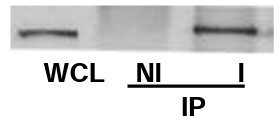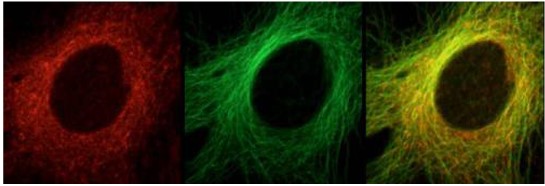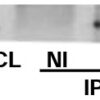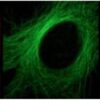Anti-ch-TOG Antibody (34032)
$288.00
SKU: 34032
Categories: Antibody Products, Cancer Research Antibodies, Products
Overview
Product Name Anti-ch-TOG Antibody (34032)
Description Anti-ch-TOG Rabbit Polyclonal Antibody
Target ch-TOG
Species Reactivity Human, Mouse
Applications WB,IF,IP
Host Rabbit
Clonality Polyclonal
Immunogen NH2 terminal cysteine-peptide corresponding to aa 2019-2032 in the carboxyl terminal region of human ch- TOG coupled to KLH: NH2-CDLKKRLERIKSSRK-COOH.
Properties
Form Liquid
Concentration Lot Specific
Formulation Whole antiserum
Buffer Formulation Whole Antiserum
Format Whole Antiserum
Purification Whole antiserum
Specificity Information
Specificity This antibody recognizes human and mouse ch-TOG. A BLAST search demonstrated 100% identity to the peptide immunogen in human, mouse, rat, chimpanzee, dog, cow, chicken, opossum, and frog.
Target Name Cytoskeleton-associated protein 5
Target ID ch-TOG
Uniprot ID Q14008
Alternative Names Colonic and hepatic tumor overexpressed gene protein, Ch-TOG
Gene Name CKAP5
Sequence Location Cytoplasm, cytoskeleton, microtubule organizing center, centrosome, Cytoplasm, cytoskeleton, spindle pole, Cytoplasm, cytoskeleton, spindle, Chromosome, centromere, kinetochore
Biological Function Binds to the plus end of microtubules and regulates microtubule dynamics and microtubule organization. Acts as processive microtubule polymerase. Promotes cytoplasmic microtubule nucleation and elongation. Plays a major role in organizing spindle poles. In spindle formation protects kinetochore microtubules from depolymerization by KIF2C and has an essential role in centrosomal microtubule assembly independently of KIF2C activity. Contributes to centrosome integrity. Acts as component of the TACC3/ch-TOG/clathrin complex proposed to contribute to stabilization of kinetochore fibers of the mitotic spindle by acting as inter-microtubule bridge. The TACC3/ch-TOG/clathrin complex is required for the maintenance of kinetochore fiber tension (PubMed:23532825). Enhances the strength of NDC80 complex-mediated kinetochore-tip microtubule attachments (PubMed:27156448). {PubMed:12569123, PubMed:18809577, PubMed:21297582, PubMed:21646404, PubMed:23532825, PubMed:27156448, PubMed:9570755}.
Research Areas Cancer research
Background Colonic and hepatic tumor over-expressed protein (ch-TOG) belongs to the TOG/XMAP215/Dis1 evolutionarily ancient family of microtubule-associated proteins with isoforms found in all major kingdoms of eukaryotes. This protein is required for the assembly and function of the meiotic or mitotic spindles during cell division and is localized to microtubule-organizing centers (MTOCs) during interphase or to the spindle poles and centrosomes during mitosis or cytokinesis.
Application Images



Description Immunoprecipitation: use at 1:5,0001:10,000 dilution. WCL NI I IP Western blot on human Hela whole cell lysate (WCL) and ch-TOG immunoprecipitated (I) from mouse embryonic fibroblast whole cell lysate. The ch-TOG antibody did not react with the mouse embryonic fibroblast whole cell lysate when non-immune sera (NI) was used in the immunoprecipitation reaction. Proteins were resolved and transferred from a 9% SDS-PAGE.

Description Immunofluorescence: use at 1:5,0001:10,000 dilution. Immunofluorescent images (100X) of a mouse fibroblast cell line labeled with ch-TOG (red), microtubules (green) demonstrating ch-TOG localizes with microtubules (yellow).
Handling
Storage This antibody is stable for at least one (1) year at -20°C. Avoid multiple freeze- thaw cycles.
Dilution Instructions Dilute in PBS or medium that is identical to that used in the assay system.
Application Instructions Immunoblotting: use at 1:5,000-1:10,000 dilution. A band of approx. 215kDa is detected.
Immunoprecipitation: use at 1:5,000- 1:10,000 dilution.
Immunofluorescence: use at 1:5,000- 1:10,000 dilution.
These are recommended concentrations. User should determine optimal concentrations for their applications.
Immunoprecipitation: use at 1:5,000- 1:10,000 dilution.
Immunofluorescence: use at 1:5,000- 1:10,000 dilution.
These are recommended concentrations. User should determine optimal concentrations for their applications.
References & Data Sheet
References Barr, A. R.& Bakal, C. Sci Rep. 2015 Jun 3
5:10564
5:10564
PMID 26037491
Data Sheet  Download PDF Data Sheet
Download PDF Data Sheet
 Download PDF Data Sheet
Download PDF Data Sheet





